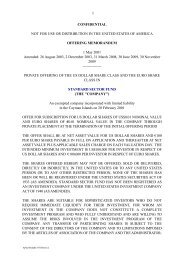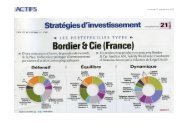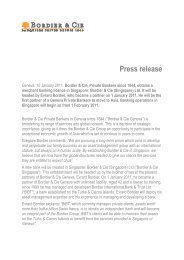The Letter - Bordier & Cie
The Letter - Bordier & Cie
The Letter - Bordier & Cie
You also want an ePaper? Increase the reach of your titles
YUMPU automatically turns print PDFs into web optimized ePapers that Google loves.
How to hedge<br />
against future infl ation<br />
1. Introduction: anticipation is vital<br />
2. Gold<br />
3. Commodities<br />
4. Property<br />
5. Equities<br />
6. Focus on infl ation and growth<br />
7. Infl ation-linked government bonds<br />
8. Conclusion: it will soon be time to buy infl ation-linked bonds<br />
1. Introduction : anticipation is vital<br />
United States, euro zone, Switzerland, United Kingdom, Japan: deep<br />
recession is everywhere. Back in July 2008 observers had still been<br />
forecasting the risk of stagfl ation with a barrel of crude priced at<br />
USD 150, but in the meantime many countries have either gone into<br />
defl ation or are about to do so. <strong>The</strong>n again the property crisis in<br />
the United States has caused a serious deterioration of bank balance<br />
sheets on both sides of the Atlantic.<br />
To fi ght the fi nancial crisis and recession, the central banks have<br />
cut their base rates to historically low levels, close to zero. As this<br />
did not seem enough to drag us out of the crisis, the central banks<br />
have even begun to practice quantitative easing policies, by which<br />
is meant that they are buying up massive quantities of government<br />
bonds, commercial paper or property-backed securities (commonly<br />
known as toxic assets). All of these purchases are helping to swell<br />
money supply hugely and in fact represent a return to the old habit<br />
of printing new bank notes. In the course of history that practice<br />
has always preceded bouts of infl ation; infl ation therefore awaits us<br />
4<br />
round the corner, sooner or later. To hedge against infl ation, economic<br />
literature identifi es gold, commodities, property and equities;<br />
more recently, infl ation-linked issues have made their appearance on<br />
the bond market.<br />
Our approach in this article will be to study the performance of<br />
these different vehicles in relation to the consumer price index in the<br />
United States (the familiar CPI) over a period of forty years in principle.<br />
We will endeavour to refi ne our analysis by looking at six periods<br />
typifi ed by different levels of infl ation, with an imminent or existing<br />
recession or on the contrary a period of vigorous growth. We have<br />
focussed on the United States because that country has the benefi t of<br />
long statistical series.<br />
15<br />
10<br />
5<br />
0<br />
8<br />
6<br />
4<br />
2<br />
0<br />
INFLATION IN THE UNITED STATES YEAR ON YEAR VARIATION<br />
FROM 01/01/69 TO 31/12/78 15 15 FROM 01/01/79 TO 31/12/88<br />
69 70 71 72 73 74 75 76 77 78<br />
FROM 01/01/89 TO 31/12/98<br />
89 90 91 92 93 94 95 96 97 98<br />
8<br />
6<br />
4<br />
2<br />
0<br />
10<br />
5<br />
0<br />
5<br />
10<br />
6<br />
4<br />
2<br />
0<br />
-2<br />
5<br />
0<br />
79 80 81 82 83 84 85 86 87 88<br />
SINCE 01/01/99<br />
99 00 01 02 03 04 05 06 07 08 09<br />
15<br />
10<br />
5<br />
0<br />
6<br />
4<br />
2<br />
0<br />
-2<br />
Source: Thomson Datastream







